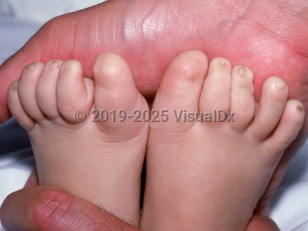Fetal hydantoin syndrome in Infant/Neonate
Alerts and Notices
Important News & Links
Synopsis

Fetal hydantoin syndrome (FHS), also known as congenital hydantoin syndrome, comprises a spectrum of structural, developmental, neurological, and behavioral abnormalities that may occur from prenatal exposure to phenytoin. Malformations include digit and nail hypoplasia, characteristic abnormal facies, rib anomalies, low hairlines, growth retardation, and abnormal palmar creases. Genital developmental aberrations and neonatal acne have also been reported. Nail findings may be the only presenting symptom, and it has been suggested that this is a mild form of FHS.
The typical facial anomalies of FHS can be subtle and overlap considerably with the clinical presentation of neonates exposed to other antiepileptic drugs (AEDs) in utero.
There have been individual case reports of patients with FHS and the following findings: hyperpigmentation of fingernails, gum hypertrophy, digitalization of the thumbs, cleft hand, hypoplasia of distal phalanges and nails, epicanthal folds, pseudohypertelorism, epidermoid cyst, truncus arteriosus, and geographic tongue.
The spectrum of severity of FHS is broad. Studies have attempted to better define the risk of developing FHS based on exposure dosages and durations, but results have been inconclusive. A 2008 study has implied that genetic factors increase susceptibility, with deficiencies in the enzyme epoxide hydrolase and mutations in methylenetetrahydrofolate genes conferring increased risk of congenital malformations induced by phenytoin and other AEDs.
The typical facial anomalies of FHS can be subtle and overlap considerably with the clinical presentation of neonates exposed to other antiepileptic drugs (AEDs) in utero.
There have been individual case reports of patients with FHS and the following findings: hyperpigmentation of fingernails, gum hypertrophy, digitalization of the thumbs, cleft hand, hypoplasia of distal phalanges and nails, epicanthal folds, pseudohypertelorism, epidermoid cyst, truncus arteriosus, and geographic tongue.
The spectrum of severity of FHS is broad. Studies have attempted to better define the risk of developing FHS based on exposure dosages and durations, but results have been inconclusive. A 2008 study has implied that genetic factors increase susceptibility, with deficiencies in the enzyme epoxide hydrolase and mutations in methylenetetrahydrofolate genes conferring increased risk of congenital malformations induced by phenytoin and other AEDs.
Codes
ICD10CM:
Q86.1 – Fetal hydantoin syndrome
SNOMEDCT:
70065001 – Fetal hydantoin syndrome
Q86.1 – Fetal hydantoin syndrome
SNOMEDCT:
70065001 – Fetal hydantoin syndrome
Look For
Subscription Required
Diagnostic Pearls
Subscription Required
Differential Diagnosis & Pitfalls

To perform a comparison, select diagnoses from the classic differential
Subscription Required
Best Tests
Subscription Required
Management Pearls
Subscription Required
Therapy
Subscription Required
References
Subscription Required
Last Updated:02/06/2022
Fetal hydantoin syndrome in Infant/Neonate

